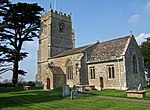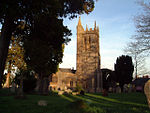Bagber
Dorset geography stubsHamlets in DorsetSturminster Newton

Bagber is a hamlet in the county of Dorset in southern England, situated about 2 miles (3.2 km) west and northwest of Sturminster Newton in the Dorset unitary authority. It consists of Bagber, Lower Bagber and Bagber Common, which all lie within Sturminster Newton civil parish. Chapel Row consists of around 10 houses in total, 6 of them being within 300 metres of the main A357. These six date back to the 19th century with the chapel now being now no. 6. The poet William Barnes was born in Bagber in 1801.
Excerpt from the Wikipedia article Bagber (License: CC BY-SA 3.0, Authors, Images).Bagber
A357,
Geographical coordinates (GPS) Address Nearby Places Show on map
Geographical coordinates (GPS)
| Latitude | Longitude |
|---|---|
| N 50.9221 ° | E -2.3514 ° |
Address
A357
DT10 2HT , Sturminster Newton
England, United Kingdom
Open on Google Maps








